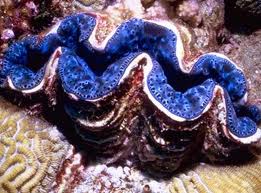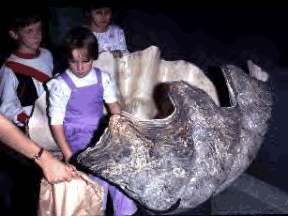|
Once there have been seven kinds of Giant clams populating in higher numbers the reef-regions of Philippine seawaters. Today however we find in the wild from the larger species especially the tridacnida gigas and deresa only small remainders on Palawan, East Samar or Island of Maricaban. The breeding and recultivation of the shells, arranged since the eighties especially by two university-institutes in the Philippines, takes place only sporadically and selective, is accompanied by setbacks and can nearly make up the loss by illegal dredging and catching. Biology What are the general characteristics of the giant clams? Let's begin with the size of the giants. The largest species the already mentioned Tridacna gigas (True Giant Clam) - can reach at most a size of 140 cm and a weight of 400 kg while the Tridacna crocea (Boring Clam) with a maximum size of 23 centimetres reaches only round about the triple size of our common (blue) mussel. Mostly the resident giant-mussels can be seen with their above opened shells and extended mantle in the sun flouted flat reef-waters up to a depth from not more than twenty meters. It is obvious that in these low depths the colourful animals can be found very easily. The thick-walled, white-grey shells have often shaped projections and scutes. The shells are hold together by powerful sphincers. The expression murderer-clam especially refers to the muscle of the giga bivalve, which can be strong as an arm. The term probably should warn divers of sudden, live-dangerous attacks. However the danger seems to be a smaller one. First encounters are very seldom, because of the small number of animals in the Philippines. Moreover according to the prevailing opinion of specialists, the shells are closed slowly not abruptly if the animal recognizes a change of light. But objects, that get into the inexorably closed shells, can often be freed only by demolishing the shells. While most of the world-wide 20.000 species of mussels find their food through filtration nutrients of the water, giant bivalves even if they have a siphon and gills for filtering the incurrent water - use primarily another technique of food-acquisition. They live in a type of waste-symbiosis with millions of microscopically small, single-celled alga-populations, which are embedded in their colored mantle. By the process of the photosynthesis, the algae deliver carbohydrates and oxygen to the clam while the clam transfers its metabolism-products (i.e. carbonic-dioxide and ammonium) to the algae for further utilization. Giant clams are hermaphrodite, they have both male and female germ-glands. First chemical messengers are announcing a mussel-wedding. Then hundreds of millions of sperm and ova are released simultaneously by the gigas species. Giant shells have a lot of predators like fishes and snails. Out of the innumerable larvae only few sexually mature animals will develop after years. From aquarium specimens we know that giant clams can reach an age of nearly ten years. Different species More information about the different species can be found on Elisabeth M. Lucans excellent Homepage (1). Here only some characteristics in brief: Tridacna giga (True giant clam): Largest giant clam with a maximum length of 140 cm / thickness of shell up to 10cm / weight can reach 400 kg, soft parts up to 10 kg / shell has 4 -5 folded rips with triangular inward projections at the upper margins / mantle mostly gold-brown, but also green and yellow / in the free nature often overgrown from sponges, corals and algae Tridacna derasa (Smooth giant clam): can reach a length from up to 60 cm / rather smooth shell, in direction of opening 6 -7 folds / hinge relatively broad / mantle mostly gold-colored, but there are also species with black, white, blue mantle / mantle often shows wavy brightly-green or brightly-blue patterns or spots
Tridacna squamosa (Fluted giant clam): up to 40 cm / thick-walled shell / 412 rounded radial-ribs with many larger fluted scales / mantle often yellow-brown and generally mottled with blue, brown or green wavy lines Tridacna maxima (Elongated giant clam): up to 35 cm / can make little movements / asymmetrical, oblong stretched shells / richly spotted, frequently blue mantle with black eye-spots at edge of the mantle / very often hold in in aquariums because of its beauty Tridacna crocea (Boring clam): smallest giant clam with a maximum length of 23 cm / boring species / relatively smooth, roundish-symmetrical shell with thick scutes in the upper parts of shells / very colourful mantle Hipopus hipopus (Strawberry clam): up to 45 cm / thick, heavy shells with triangular, horse-hoof-similar valves at the broad base, when the clam is closed / greenish to brownish mantle with reddish stains / mantle does not extend past the edge of the shell Hipopus porcellanus (China clam): almost extincted / in the Philippines only in very limited areas / whitish less ribbed shells Usages
Prohibition, Aqua-Farming and Re-Introduction However the relatively abundant stocks of giant clams have been reduced dramatically in the indo-pacific area by excessive harvesting. Less because there exists an aquarium trade. The main cause is the strong demand for clam-meat by the gastronomy of the neighbouring southeast-Asian countries. The demand is pushed by the rumour, that the sphincter-meat like the meat of seahorses (2) would have potency-increasing effects. Special fishing-boats with dredging-techniques as well as special-knives to remove the sphincters, have been developed to get quick and rich harvests. Especially the bigger, sexually mature animals, who are so important for the reproduction of the species, fell victim to the hunt-pressure. The local extinction and decimation of giant clams led in the eighties to legal sanctions. All species of giant clams are listed now in the Appendix II of the Convention on the International Trade of Endangered Species of Wild Flora and Fauna (CITES). And there are special legal regulations for the Philippines (FAO 158 and 168), that prohibit the collecting, property, sale and export of giant clams involving the risk of money or prison punishment (3). But regulations exist first only on paper, the implementation of laws leaves much to be desired. More control-efforts are needed. The high price level for clam-meat still provokes an existing giant clam-mafia (4) to continue the illegal fishing and trade. In the Internet we found hints, that some restaurants in the country still offer clam-meat. But it is not clear, if the meat comes from animals in the free nature or from aqua-farming. And this gives us an other topic. In order to decrease the hunt-pressure on the freely living populations, experts ask emphatically for more establishments of commercial clam farms. It is told that the juvenile and nursery production as well as the restocking in suitable positions of the reef is not too difficult and is regarded as high profitable. Giant clams for the aquarium trade have prices between 15 and 120 US$ according to species and size. Aquarium clams need 12 18 months as grow-out time to harvest, while food clams need 2-3 years. If they are in sea water, they are self-sufficient. In the meantime we have also in the Philippines such commercial farms, for example in Ilijan in the province Batangas. The Navy Science Institute of the University of the Philippines in Diliman or the Navy Laboratory of the Silliman University in Dumaguete City are offering clam larvae. These institutes and here the name of Dr. Edgardo Gomez should be mentioned have done a lot with regard to the restocking of giant clams in free nature. With the help of non-government organisations and community-authorities giant clams were restocked for example in the sites of: Anda, Pangasinan / Masinioc, Zambales / Calape, Bohol / Camotes, Cebu / Ilocos Norte, Luzon / Tawi-Tawi, Mindanao / Hundred Island National Park But the recultivation suffered also setbacks. End of the year 2001 more than one dozen of giant clams were killed by divers in a fish sanctuary in barrio San Pablo, Bauan, Batangas. And the Philippine Marine Science Institute reported in May 2003, that in Bolinao, Pangasinan 27 full-grown giant clams have been poached. The thieves took only the clams meat and left the remaining body and shells behind. (1) Elisabeth M. Lukan, in: http://www.petsforum.com/fishnchips/issueindex.html (2) See also my article: The commercialised seahorses (3) Besides, these regulations are also valid for corals as well as for window pane shells, smooth shells, rough shells, turban shells, black lip and gold lip shells below a specified size (4) Daniel Knop, Zwischen Mythos und Wissenschaft: Die Riesenmuscheln, in: www.knop.de/d/magazin/riesenmuscheln.htm © Wolfgang Bethge, 2004 |

 Giant
clams have always been harvested by the local population in the
past. Especially
the (sphincter) meat of the smaller, less tough clams was
cooked, fried or dried a delicacy in the food-plan.
Mussel-skewers were popular. The relatively thick-walled shells
were used in very different way, for example as soup plates,
salad bowls, ashtrays, pig-troughs, bath tub for children,
kitsch articles for tourists or even as baptism or holy-water
font. More trivial was the use of the shells as
construction-material. Heaps of broken unused shells can still
be seen at shells-cemeterys today.
Giant
clams have always been harvested by the local population in the
past. Especially
the (sphincter) meat of the smaller, less tough clams was
cooked, fried or dried a delicacy in the food-plan.
Mussel-skewers were popular. The relatively thick-walled shells
were used in very different way, for example as soup plates,
salad bowls, ashtrays, pig-troughs, bath tub for children,
kitsch articles for tourists or even as baptism or holy-water
font. More trivial was the use of the shells as
construction-material. Heaps of broken unused shells can still
be seen at shells-cemeterys today.